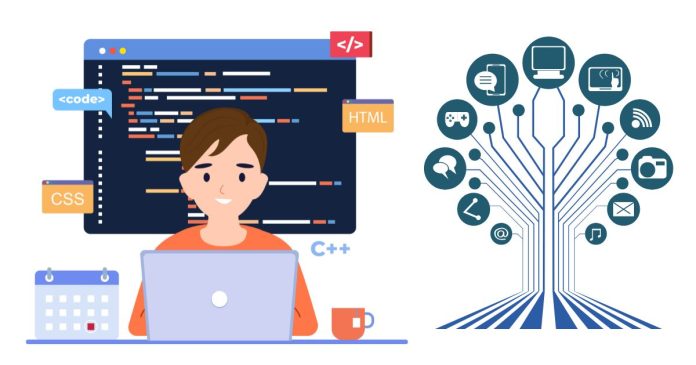Software Engineering is the discipline that involves the application of engineering principles to the design, development, maintenance, testing, and evaluation of software systems. It aims to create software that is reliable, efficient, scalable, and meets the needs of users and stakeholders.
Key Concepts in Software Engineering:
- Software Development Life Cycle (SDLC): The SDLC is a structured approach to software development that outlines the stages through which a software project passes. It includes:
- Requirements Gathering: Understanding and documenting what users need from the software.
- Design: Creating architectural and detailed designs of the system.
- Implementation (Coding): Writing the actual code that forms the software.
- Testing: Ensuring the software works as intended and is free of defects.
- Deployment: Installing the software on users’ systems.
- Maintenance: Updating the software to fix issues or add new features after release.
These stages may be executed in different methodologies, such as Waterfall, Agile, or DevOps.
- Software Development Methodologies: Different approaches to managing software projects exist, each with its advantages and use cases:
- Waterfall: A linear and sequential model where each phase is completed before the next one begins.
- Agile: An iterative approach that involves short cycles (sprints) of development, allowing flexibility and regular feedback from stakeholders.
- DevOps: A culture that combines software development (Dev) and IT operations (Ops) to shorten the development life cycle and provide continuous delivery with high software quality.
- Scrum: A specific Agile framework that organizes work into short “sprints” (usually 2-4 weeks), with constant communication and review.
- Software Design and Architecture: Software engineering emphasizes the design of robust, scalable, and maintainable software systems. This involves:
- High-Level Design: Creating an overall system architecture and selecting appropriate technologies (e.g., cloud, databases, frameworks).
- Low-Level Design: Detailing specific components, data structures, and algorithms.
- Design Patterns: Proven solutions to common software design problems (e.g., Singleton, Factory, Observer).
- Testing and Quality Assurance: Testing ensures that software works as expected and meets quality standards. Common types of software testing include:
- Unit Testing: Testing individual components or functions.
- Integration Testing: Ensuring that different parts of the system work together.
- System Testing: Verifying that the whole system meets the requirements.
- Acceptance Testing: Ensuring that the software satisfies user needs and business requirements.
- Automated Testing: Using tools and scripts to automatically run tests and check software behavior.
- Software Maintenance: After software is deployed, it undergoes maintenance to fix defects, improve performance, and add new features. Types of maintenance include:
- Corrective Maintenance: Fixing bugs and issues.
- Adaptive Maintenance: Updating software to work with new environments or technologies.
- Perfective Maintenance: Enhancing software to improve its performance or add features.
- Preventive Maintenance: Making changes to prevent potential future problems.
- Software Documentation: Good documentation is essential in software engineering to help developers, testers, and stakeholders understand how the software works. This includes:
- Technical Documentation: Describes the architecture, codebase, APIs, and systems.
- User Documentation: Guides end-users on how to use the software effectively.
- Maintenance Documentation: Assists in maintaining and updating the software over time.
- Project Management: Managing software projects is crucial for ensuring that they are completed on time, within scope, and on budget. This includes:
- Project Planning: Defining the scope, timeline, and resources needed.
- Risk Management: Identifying and mitigating risks that could delay or derail the project.
- Resource Management: Allocating human, technological, and financial resources effectively.
- Tracking and Reporting: Monitoring progress and reporting on the project’s status.
- Software Metrics: To assess the quality and performance of software, engineers use various metrics, such as:
- Code Complexity: Measures how complex or difficult the code is to understand and maintain.
- Defect Density: The number of bugs found per unit of code.
- Performance Metrics: How well the software performs under different conditions (e.g., response time, throughput).
Importance of Software Engineering:
- Quality Assurance: Software engineering ensures the software is of high quality and meets user expectations. It emphasizes building software that is robust, secure, and bug-free.
- Efficiency: The structured approach to development, testing, and maintenance improves efficiency by reducing redundancy, minimizing errors, and making use of reusable components.
- Scalability and Maintainability: Software engineering principles ensure that systems can be scaled to handle more users or data and maintained over time as needs change.
- Cost Management: By following established methodologies and best practices, software engineering can help control costs by avoiding unnecessary development or rework.
- Security: Software engineers implement security practices to protect systems and user data from malicious attacks or vulnerabilities.
- Collaboration: Software engineering encourages team collaboration and communication, allowing developers, testers, and other stakeholders to work together toward a common goal.
Conclusion:
Software engineering is an essential field for creating high-quality software systems that are reliable, maintainable, and scalable. By applying engineering principles, software engineers ensure that software development is efficient, predictable, and capable of meeting user needs. Whether using traditional methods like Waterfall or modern Agile approaches, software engineering continues to evolve, incorporating new tools, practices, and technologies to meet the ever-changing demands of the industry.


